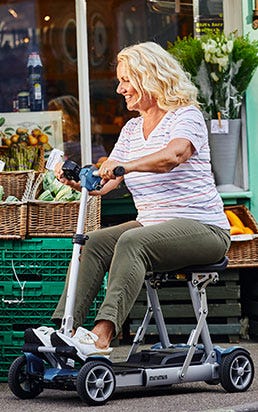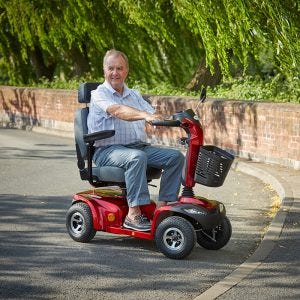One of the most common questions customers ask us is, where can they legally drive their mobility scooter?
There is so much misunderstanding on this topic that mobility scooter owners are often just as concerned that they are breaking rules as able bodied members of the public who are often quick to criticise and complain.
So today we'll put everybody straight and answer the most common questions about mobility scooters.
Are Mobility Scooters Allowed on Pavements?
Yes! Mobility scooters are separated into 2 classes by the government. Class 2 mobility scooters are pavements scooters. The only rule is that a pavement scooter must not travel faster than 4 mph. Other than that, they have as much right to use pavements as pedestrians. The official government definition:
- ‘Class 2 invalid carriages’ - these cannot be used on the road (except where there is not a pavement) and have a maximum speed of 4 mph
- ‘Class 3 invalid carriages’ - these can be used on the road, and have a maximum speed of 4 mph off the road, and 8 mph on the road
Are Mobility Scooters Allowed on Roads?
Yes! Some mobility scooters are allowed on the road - these are class 3 road legal scooters.
These scooters can have a top speed of 8 mph - any scooter that can go faster is deemed illegal. Road scooters must have lights, reflectors, indicators and hazard warning lights. They must also have efficient braking systems, a horn and rear view mirror.
If your road scooter does not have all the required features in good working order, you may be stopped by the police. Owners must register them and insure them. A driving licence is not required, but it is advisable for anybody who has not drive a car to get some training.
There are several road safety courses around the country, some are run by independent groups and some by insurance companies.
Some police centres offer free training sessions, and the Road Safety knowledge Centre provides a directory of training courses. The minimum age to ride a mobility scooter on the road is 14.
Can Mobility Scooters Go on Dual Carriageways?
Yes! This is the biggest surprise to both scooter users and car owners. Class 3 mobility scooters can be driven on a dual carriageway, but the must have an active flashing amber light.
However, it is highly advisable not to drive on a dual carriageway with a speed limit of over 50 mph. You cannot go on a motorway.
Can Road Mobility Scooters Go On The Pavement?
Yes! Road legal scooters are also allowed on pavements, but they must not be driven faster than 4 mph.
All road scooters must come with pavement speed limiters to prevent riders accidentally going too fast and breaking the speed limit. They must not be parked on pavements where they cause an obstruction.
Can Scooters Ride on Cycle Lanes or Bus Lanes?
Scooters must not be driven on cycle lanes or bus lanes - you must ride on the main part of the road, or the pavement.
Are Mobility Scooters Allowed in Shops?
Yes! By law all public buildings must have disabled access, and this includes access for mobility scooters.
However, if you have a large, all-terrain vehicle you may struggle to navigate around some shops as the access is usually designed for wheelchairs and smaller pavement mobility scooters.
Obviously if you do enter a shop, you must continue at pedestrian speed of no more than 4 mph - people tend to walk slower in shops, so it is best to go no faster than 3 mph.
If you plan to use a mobility scooter for shopping it is advisable to use a smaller folding scooter or compact pavement scooter, as they will be easier to ride around shops. Come along to one of our mobility shops and test out the different scooters before buying.
Are Mobility Scooters Allowed on Buses?
The Confederation of Passenger Transport (CPT) sets out a code of practice for using mobility scooters on buses.
If you wish to take your scooter on a bus you will be asked to complete a training session in boarding and exiting buses safely, and if you pass the training you will be given a permit that allows travel on buses that have signed up to the Code.
Not all bus companies are currently signed up though, and some may have their own rules, so always ask first. London buses do not allow mobility scooters, but they do allow powerchairs (electric wheelchairs) as these fit within the disabled travellers allocated spaces.
And Trains?
Trains, like buses, vary in their rules. Some will allow small scooters to be parked in the wheelchair / disabled areas on trains, but many trains do not have these facilities and the only practical option is often to take a folding scooter that can be stored in the luggage area while you take a seat.
If you are likely to be travelling by train often then an electric scooter might be the best option.
National Rail provide details for all their lines on the maximum size of scooters. If you have any questions feel free to call our sales team or chat to our mobility experts in one of our showrooms.


 Price Match Promise
Price Match Promise
 Next day delivery, 7 days a week
Next day delivery, 7 days a week
 Nationwide Showrooms
Nationwide Showrooms
 Rated Excellent
Rated Excellent






